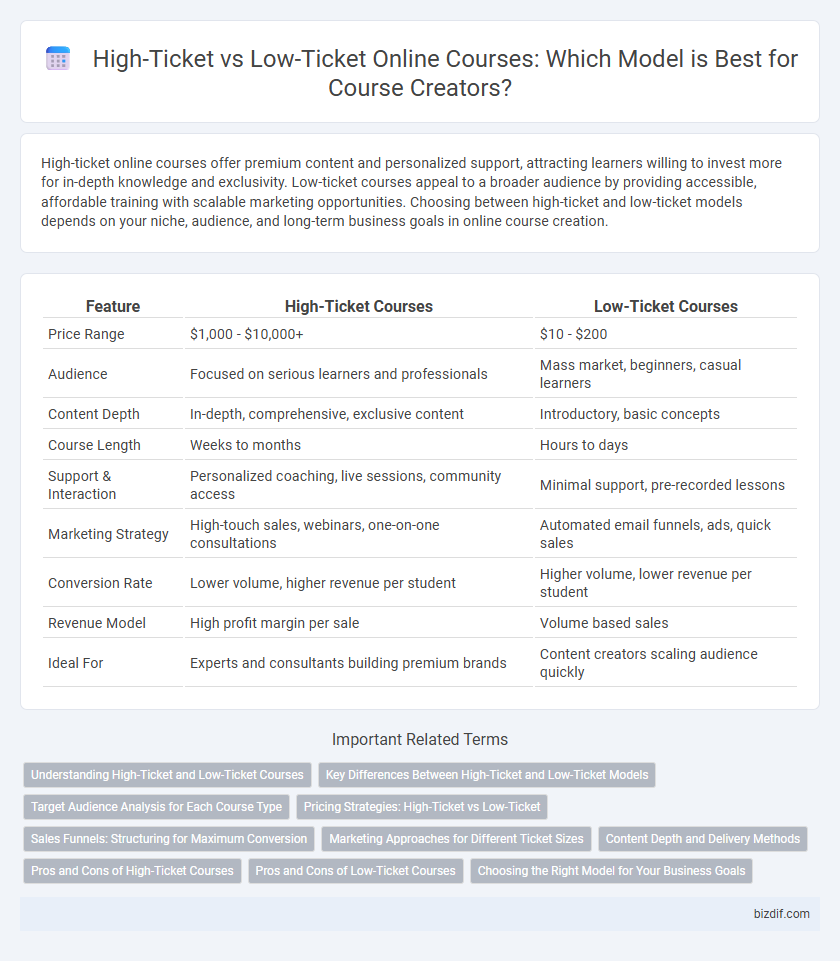High-ticket online courses offer premium content and personalized support, attracting learners willing to invest more for in-depth knowledge and exclusivity. Low-ticket courses appeal to a broader audience by providing accessible, affordable training with scalable marketing opportunities. Choosing between high-ticket and low-ticket models depends on your niche, audience, and long-term business goals in online course creation.
Table of Comparison
| Feature | High-Ticket Courses | Low-Ticket Courses |
|---|---|---|
| Price Range | $1,000 - $10,000+ | $10 - $200 |
| Audience | Focused on serious learners and professionals | Mass market, beginners, casual learners |
| Content Depth | In-depth, comprehensive, exclusive content | Introductory, basic concepts |
| Course Length | Weeks to months | Hours to days |
| Support & Interaction | Personalized coaching, live sessions, community access | Minimal support, pre-recorded lessons |
| Marketing Strategy | High-touch sales, webinars, one-on-one consultations | Automated email funnels, ads, quick sales |
| Conversion Rate | Lower volume, higher revenue per student | Higher volume, lower revenue per student |
| Revenue Model | High profit margin per sale | Volume based sales |
| Ideal For | Experts and consultants building premium brands | Content creators scaling audience quickly |
Understanding High-Ticket and Low-Ticket Courses
High-ticket courses typically offer in-depth content, personalized coaching, and exclusive resources, commanding prices upwards of $1,000 due to their high value and targeted audience. Low-ticket courses are priced under $100, focusing on broad, accessible content suitable for beginners or those seeking quick skill acquisition without extensive customization. Understanding the distinctions between high-ticket and low-ticket courses enables creators to align pricing strategies with customer expectations and course delivery models.
Key Differences Between High-Ticket and Low-Ticket Models
High-ticket online courses typically offer in-depth content, personalized coaching, and exclusive resources, commanding prices above $1,000, while low-ticket courses focus on mass-market accessibility with prices usually under $100. High-ticket models emphasize quality, niche expertise, and a smaller, engaged audience, whereas low-ticket courses prioritize volume sales, automated delivery, and broader appeal. Conversion strategies for high-ticket courses often involve direct sales and relationship building, contrasting with funnel-driven, high-traffic marketing approaches used in low-ticket models.
Target Audience Analysis for Each Course Type
High-ticket online courses target professionals and businesses willing to invest in in-depth, specialized knowledge with higher ROI potential, emphasizing personalized support and advanced content. Low-ticket courses appeal to beginners or budget-conscious learners seeking accessible, broad-based skills with quick outcomes and minimal commitment. Accurate target audience analysis ensures course pricing aligns with user expectations and maximizes enrollment by addressing specific pain points and learning goals.
Pricing Strategies: High-Ticket vs Low-Ticket
High-ticket pricing strategies focus on offering premium online courses with comprehensive content, personalized support, and exclusive access, attracting committed learners willing to invest significantly for deeper value. Low-ticket pricing emphasizes affordability and volume, targeting a broader audience with simplified course offerings and lower entry barriers to maximize enrollment numbers. Choosing between high-ticket and low-ticket models depends on audience segmentation, course complexity, and desired profit margins within the online education market.
Sales Funnels: Structuring for Maximum Conversion
High-ticket online courses require personalized sales funnels with targeted email sequences and live webinars to build trust and justify higher prices. Low-ticket courses benefit from automated funnels using simple landing pages and upsell offers to maximize volume sales. Optimizing each sales funnel stage with clear calls-to-action and strategic lead magnets enhances overall conversion rates and revenue growth.
Marketing Approaches for Different Ticket Sizes
High-ticket online courses require personalized marketing strategies emphasizing value, transformation, and exclusivity through targeted webinars, one-on-one consultations, and high-conversion email campaigns. Low-ticket courses benefit from broad-reach tactics such as social media ads, content marketing, and automated sales funnels to attract large volumes of price-sensitive learners. Understanding customer journey stages and tailoring messaging to perceived investment levels optimizes conversion rates across different ticket sizes.
Content Depth and Delivery Methods
High-ticket online courses typically offer in-depth content with comprehensive modules, expert-led video lessons, and personalized coaching or mentorship, enhancing learner engagement and value. Low-ticket courses often focus on foundational knowledge with shorter videos, downloadable resources, and automated email support, catering to a broader audience with quicker results. Choosing the right delivery method--live webinars, interactive assignments, or self-paced videos--affects content absorption and perceived course value significantly.
Pros and Cons of High-Ticket Courses
High-ticket online courses typically offer in-depth content, personalized coaching, and exclusive resources, attracting committed learners willing to invest significantly in their education. The main advantages include higher revenue per sale and increased perceived value, but challenges involve a smaller target audience and greater pressure to deliver exceptional results. High-ticket course creators often face the need for advanced marketing strategies and comprehensive support systems to justify the premium pricing.
Pros and Cons of Low-Ticket Courses
Low-ticket online courses offer affordable access, attracting a larger audience and enabling rapid sales volume, which can generate steady revenue streams. However, they often require higher marketing efforts and continuous content updates to maintain engagement and competitive pricing. The lower price point may also lead to reduced perceived value and limited profit margins compared to high-ticket courses.
Choosing the Right Model for Your Business Goals
High-ticket courses generate significant revenue per sale, ideal for businesses targeting premium clients and personalized support, while low-ticket courses attract larger audiences with scalable, affordable content. Understanding your niche's willingness to invest and your capacity for delivering value guides the choice between high-ticket and low-ticket models. Aligning course pricing with business goals ensures sustainable growth and maximized profitability in online course creation.
High-ticket vs Low-ticket Infographic

 bizdif.com
bizdif.com